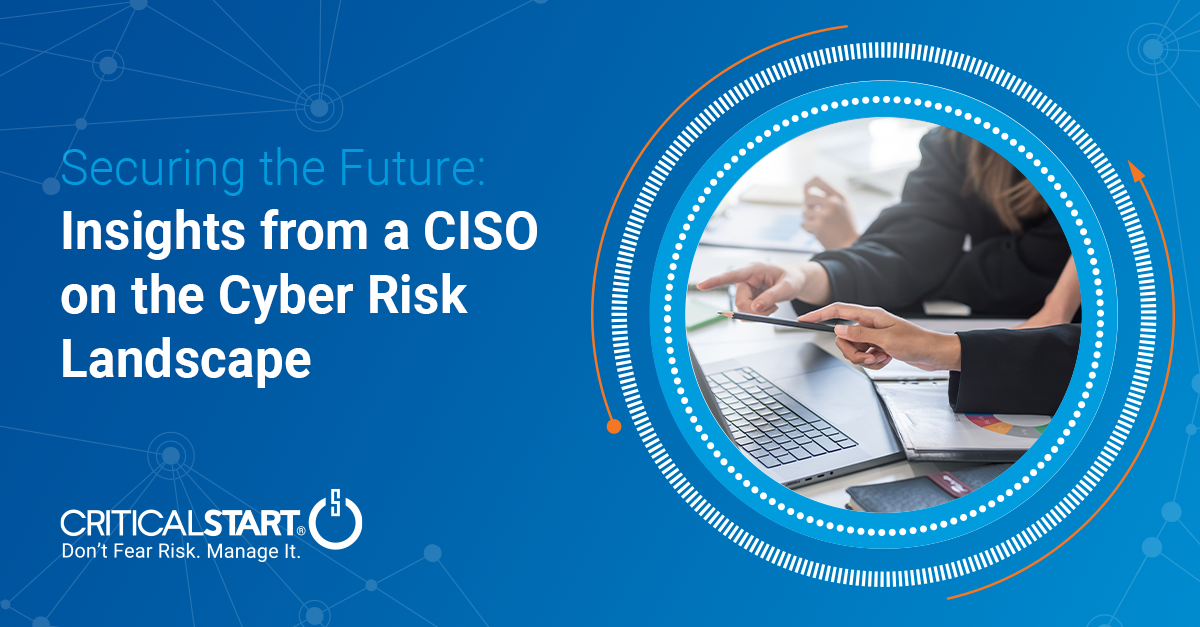Securing the Future: Insights from a CISO on the Cyber Risk Landscape

As a security leader, there are plenty of challenges that stand between your team (or perhaps, just you) and protecting your entire organization. While many CISOs, CIOs, and other cyber leaders deal with a lack of data, resources, and staffing issues, it’s important to remember that you’re not alone. As a CISO in the cybersecurity industry, our organization’s job as a pioneer in Managed Detection and Response (MDR) is to support you and learn about your needs.
Our latest study, the Critical Start 2023 Cyber Risk Landscape Peer Report, offers us a profound understanding of prevailing cybersecurity concerns and obstacles. This report comes at a time when we, as leaders, grapple with the pressing need to showcase our organization’s risk acceptance and risk management strategies.
Cyber Risk Landscape Insights that Resonate
The insights that stand out to me from this study include:
- Traditional security approaches are falling short, as 67% of organizations experienced breaches over the past two years despite their efforts.
- Limited visibility into our cyber risk profiles hampers effective decision-making for 66% of businesses.
- A remarkable 93% of us are considering offloading specific risk reduction tasks to security service providers.
- There is a glaring misalignment between cybersecurity investments and risk reduction priorities, concerning 61% of executives.
- A unanimous belief (93%) that embracing an evidenced-based approach to cyber risk management can avert significant incidents is evident.
- A striking 74% responded that they would like to prioritize proactive risk reduction strategies, such as continuous risk monitoring and timely incident response.
Moreover, the landscape is shifting. A resounding 82% of us believe that managed cyber risk reduction strategies will deliver profound cyber protection value. The message is clear: traditional strategies are no longer enough, and an evolution is underway.
The Conundrum of Cyber Risk Management
A major challenge we all face as cyber leaders lies in aligning our cybersecurity measures with our organization’s risk appetite. Yet, data accessibility and analysis continue to be difficult, leaving us wrestling with manual tasks that slow our need to make quick, informed decisions. There is also a significant lack of metrics available to us that show how effectively we are managing risk, and how we compare to our peers. Beyond the issue of managing risk, there is the question of “How do we quantify it?” When speaking with other CISOs, this is a challenge I hear often.
A Need for Confidence and Collaboration
Like previously mentioned, the report reveals that 67% of organizations faced cyber incidents despite traditional security measures. In addition, 66% cite limited visibility as a concern, while resource constraints and budget limitations add to the complexity. It’s a circular challenge – understanding risk requires significant investment, yet demonstrating the impact continues to be difficult without access to data and measurable results.
Security leaders need risk identification, continuous analysis, and a tangible link between risk assessment and improvements. The imperative is clear: we must move from potentially gambling with our security investments to confidently making informed decisions.
A Call for Enhanced Cyber Risk Management
As the leaders of the security strategy at our organizations, we are well aware of the rising complexities that threat actors bring to the table. It’s imperative that we define the extent of cyber risk our organizations are willing to embrace in a way that leadership and boards understand. We need to feel empowered to proactively and holistically take control of our cyber risk reduction.
We live in a world where transparency is key, not only within our direct teams, but also to other departments and stakeholders. Our latest report also shines a light on the need for a fresh approach – one that hinges on holistic and evidenced-based cyber risk management.
Embracing Managed Cyber Risk Reduction (MCRR)
Critical Start is leading the way with MCRR, an evolution of MDR. MCRR extends beyond detection and response, encompassing identification, protection, and recovery.
Critical Start supports organizations in strengthening their security posture over time. With a risk-based approach, we mitigate risks cost-effectively, while aligning cyber protection with organizational goals. Our MCRR strategy empowers security leaders to continuously identify, measure, and act on cyber risks.
A Secure Future Awaits
In concluding this report, we gather key takeaways:
- Organizations are embracing proactive cyber risk reduction solutions.
- Risk reduction initiatives are paramount in a dynamic threat landscape.
- Collaboration is crucial to navigate multifaceted threats.
- Continuous risk assessment fosters resilience.
With the evolving threat landscape and the critical need for proactive risk management, CISOs and CIOs have a pivotal role to play. Partnering with industry leaders like Critical Start can help organizations take a proactive approach to cybersecurity, and gain more control.
Our path forward is clear: Managed Cyber Risk Reduction and continuous risk assessment are both key to proactive protection. Check out our Cyber Risk Landscape Peer Report to learn more, including recommendations on how security leaders can evolve strategies to include MCRR and better align to industry-leading frameworks.

In his role as the CISO, George defines and drives the strategic direction of corporate IT, information security and compliance initiatives for the company, while ensuring adherence and delivery to our massive growth plans. George brings more than 20 years of experience with technology, infrastructure, compliance, and assessment in multiple roles across different business verticals.
You may also be interested in…
RESOURCE CATEGORIES
- Buyer's Guides(1)
- Consumer Education(39)
- Consumer Stories(2)
- Cybersecurity Consulting(4)
- Data Breaches(15)
- Data Privacy(43)
- Incident Response(2)
- Interview(51)
- MDR Services(59)
- MobileSOC(6)
- News(5)
- Press Release(101)
- Research Report(9)
- Security Assessments(2)
- Thought Leadership(19)
- Threat Hunting(3)
- Video(1)
- Vulnerability Disclosure(1)